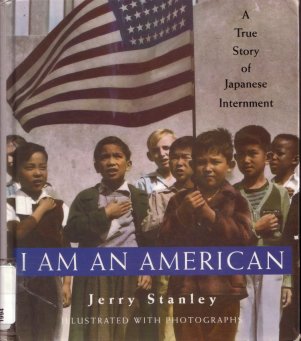
I AM AN AMERICAN

Book by Jerry Stanley, 1994
(Note: Any comments of mine on the material in the book are put in parentheses)
This book is centered around the story of one person, Shiro Nimura, a Nisei, a senior in high school, and a Japanese-American who was totally loyal to the U.S., didn't even speak Japanese, and preferred American culture to Japanese.
The book tells about Shiro's parents but weaves into their story the events going on at the time including the vicious prejudice against Japanese on the west coast, not only prior to WWII but decades before the war.
(Shiro himself was not very lucky. He was hit in the head by a shot put, paralyzing him for six months, and on the night of December 6 he was in a car accident.)
The book notes that the Japanese-Americans tried very hard to demonstrate their patriotism but it didn't stop them from being interned. (Racial prejudice and greed trump logic and intelligence almost every time.)
The book notes some of the more idiotic reports of Japanese "sabotage and spying" and how every one of those turned out to be totally false or common things mistaken for spying, such as a "flaming arrow" supposedly pointing the way for Japanese bombers really being nothing but a natural wildfire.
In the two months after Pearl Harbor there were 37 cases of Japanese-American individuals being attacked by gangs on the west coast with a result of seven dead.
There were almost 52,000 Italian aliens and over 19,000 German aliens (people not born in the U.S.) in California and some 600,000 German citizens living in the U.S. overall but only a very small number of either of these were ever interned.
The book details some of the ways the Japanese-Americans were mistreated by greedy whites who bought their property at ridiculously low prices. Further, some whites even hated whites who happened to like the Japanese.
Shiro's family was sent to the Manzanar camp. One of the strongest points of this book is how it is so personal by dealing with the lives of a small number of people in some detail. It makes the book quite interesting.
The next part of the book deals with how the Japanese-Americans served in the military as interpreters in the Pacific theater and in combat groups in Europe.
When the camps were being closed Japanese-Americans returning to their former homes often found trouble. Various white organizations had arisen such as No Japs Incorporated in San Diego and the Home Front Commandos in San Francisco. On the other hand various movie stars and the American Legion wanted the Japanese-Americans to be treated fairly.
80% of the goods that the Japanese-Americans had stored before their evacuations turned out to have been rifled, stolen or sold. They lost over $400 million in property.
This is yet another good book and well worth reading.
Main Index
Japan main page
Japanese-American Internment Camps index page
Japan and World War II index page
|